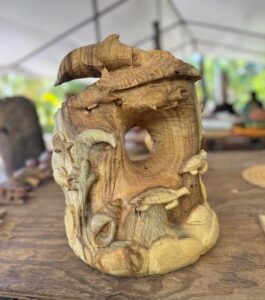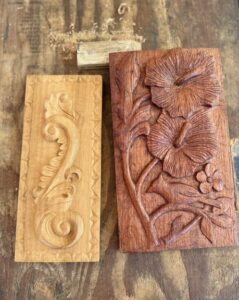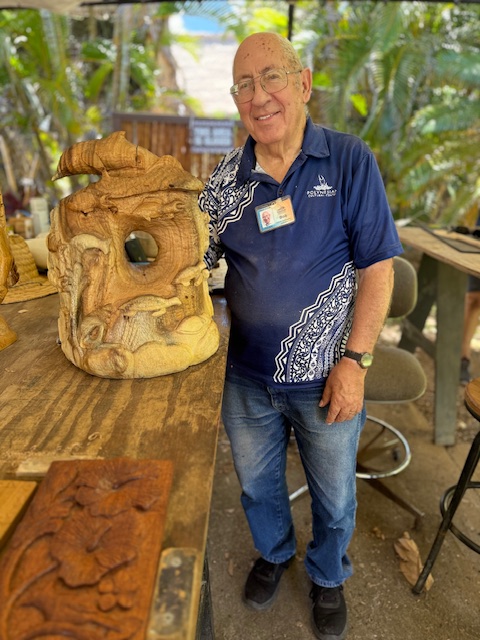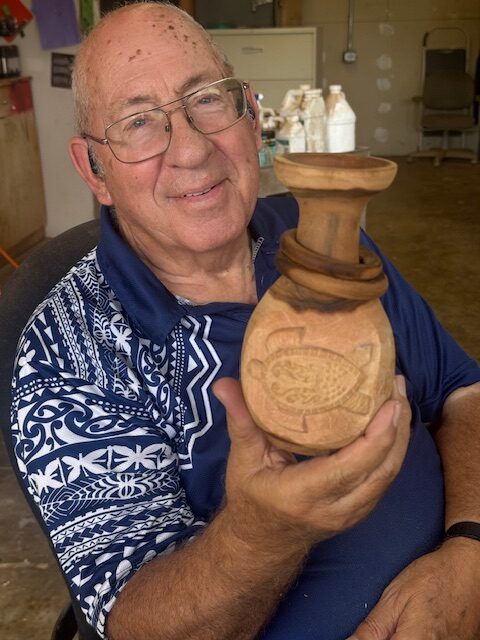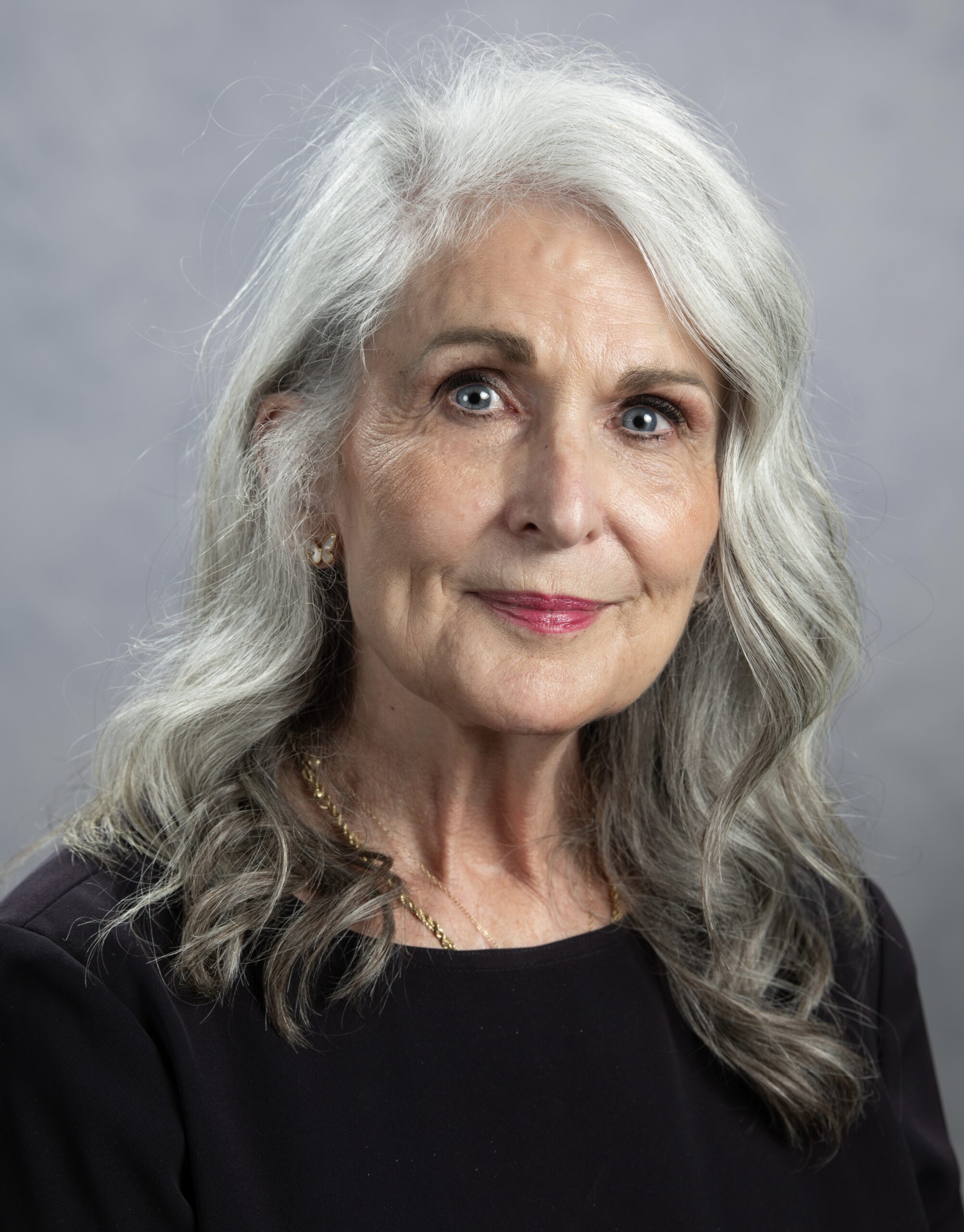From Arizona to Lāʻie: A Mission of Faith and Craftsmanship
At 83 years young, Elder Robert (Bob) Palmer from Phoenix, Arizona, is serving his third full-time mission for The Church of Jesus Christ of Latter-day Saints as a senior missionary and specialist at the Polynesian Cultural Center (PCC) in Lāʻie, Hawaiʻi. He credits Elder Ronald A Rasband’s stirring talk in the October 2023 General Conference—calling for more senior missionaries—as the spark that inspired him and his wife, Anne, to serve:
“This opportunity came to me after hearing a talk by Elder Rasband. I started researching opportunities and found four possibilities. This mission has really helped my spiritual life. It’s been a reminder of some of the miracles that got us here, for one thing. At my age, I wasn’t sure they would even take me, but I think President Nelson’s older age kind of opened up the ceiling a bit.
When I was serving a 2010 mission in Nauvoo as a senior missionary, it would’ve been a very unusual situation to have somebody 80 years old still serving a mission.”
At the PCC, Elder Palmer focuses on wood carving and interacting with visitors as he creates artwork for the Island Villages and other areas of the Center. He shares not only his skills but also his deep love for meaningful craftsmanship:
“Meeting so many fascinating people from all over the world has been so rewarding—people from Asian countries, European countries, China, all over the globe. It’s been interesting to communicate with them here in the carving area near the Tahiti village. People who are carvers seem to like to pick my brain a little, too.”
Crafting Sea Life from the Heart of the Wood
Elder Palmer recently completed a whimsical 18-inch sculpture titled Sea Life, carved from monkeypod wood. The piece—which took between 160 and 180 hours to complete—captures a variety of marine life in motion, frozen in time through masterful craftsmanship. The richly grained wood is found in Hawaiʻi and is prized for its natural streaks of red and brown. Bob felt the wood itself hinted at hidden ocean treasures:
“Quite often it’s a matter of deciding what I want to make and then finding the right piece of wood to use. With this sculpture, I just picked up a piece of wood and it seemed right.
Most of the time, I have an idea of what I want to make and then try to find a piece of wood that would work for that. But sometimes the piece of wood itself—because of the grain or shape—gives me the idea and motivation for what to make.
I started sketching out some ideas on a piece of paper and decided that what I wanted to do could include several species of sea life and even some plants.”
With decades of experience and instincts as sharp as his carving tools, Bob began working on the large stump with calculated precision. Each chip and cut revealed playful dolphins, floating turtles, polished shells, and underwater flora. The finished piece is now proudly displayed in the Ambassador’s Lounge, a staging area for guided tours at the PCC.
Whittling for Pleasure and Purpose
Bob’s passion for carving began when he was just ten years old in Flagstaff, Arizona. One Christmas, he and his brother received an X-Acto carving set from their parents. From his very first attempt—carving a small horse—he was hooked:
“So I just started there, and every chance I had, I’d do a little carving. You don’t really need a set of tools to begin—just a pocketknife will work.”
That simple gift sparked a lifelong journey. Over the years, carving became more than a hobby—it became a vocation. Bob admits with a wry smile that he has cut every finger and both hands numerous times, but despite the injuries, his whittling continues to be a source of great satisfaction in his life.
He has created hundreds of art pieces—for personal enjoyment, family, teaching, and on commission. Among his commissioned works is The Last Supper, which is now displayed on a communion table in a Church of Christ chapel near Phoenix. Negotiating the terms of that piece required time and flexibility:
“The man had talked to me about doing it a couple of years earlier; he took all that time to consider it and finally came to my shop and asked if I would still be interested.
I came down a lot, he came up a little, and we agreed on the price. Sometimes you have to devalue your art to a degree to get the work.
I’ve figured that some of the jobs I earned maybe five cents an hour. And then some of them I made thirty or forty dollars an hour.”
Sculpting Scripture: Lehi’s Seer Staff
Another unique and spiritually significant piece Bob created was a seven-foot sculpture titled Lehi’s Seer Staff, which features icons from Lehi’s journey—including the Liahona, the gold plates, and a ship symbolizing the family’s journey. The right wood came through an unexpected discovery:
“There were a bunch of trimmings and stuff in the alley, and my wife was out there weeding and cleaning up the area.
She told me there’s some scrap wood being thrown out behind the neighbor’s house. It was olive wood.
The piece just happened to be about the right height and thickness and had very few cracks in it.”
The client was thrilled to learn that the sculpture was made from olive wood—symbolic of the House of Israel and meaningful in connection to Lehi’s descendants.
Faith, Culture, and the Legacy of Art
Bob treasures the spiritual nourishment he receives from devotionals at BYU–Hawaiʻi, where he has heard from four latter-day Apostles, including Elders Rasband, Renlund, Gong, and Christofferson.
He emphasizes the importance of understanding and appreciating different cultures—especially identifying the elements that align with the teachings of Christ. Reflecting on the preservation of culture at the PCC and elsewhere, Bob observes:
“It’s interesting to note how cultures such as Egypt and Mexico tried to preserve the things they believed in for future generations to know.
We all benefit from those historical things. Those lessons are present in art—especially in architectural elements. I think of a member of our faith, Avard T. Fairbanks, who was a sculptor and quite an artist. He sculpted several statues of Lincoln – one is in the Capitol building in Washington DC. He created the friezes, baptismal font, and oxen for the Lāʻie Hawaiʻi Temple. The carvings at the temple in Lāʻie are so beautiful.”
The PCC holds many architectural treasures including the amazing carvings of the buildings in Aotearoa Island Village, and the 60- foot war canoe. Bob learned there are many types of carving represented in artifacts and buildings here within its 42 acres:
“Carvings that I’ve done in the past gave me some skills that were helpful to do more intricate carving with regard to the culture of the Polynesian people. There were also things that I had not carved such as a taiaha and patu, both weapons of war for the Maori people. It’s been amazing to me to understand the talent that it took to do some of those carvings. I made both a patu which is a hand-held weapon and a taiaha which is a staff.”
Interestingly, the patu wasn’t just useful in subduing the enemy but symbolized status, authority and mana (prestige) in the Maori culture.
A Teacher’s Heart and a Craftsman’s Hands
Among Bob’s most cherished life experiences was teaching industrial arts to youth. Hundreds of students passed through his classes—some learning to build furniture, carve bolo ties, or create even more elaborate works. He could quickly spot which students had the gift of visualizing the possibilities as they made initial cuts. At least one of his students went on to start his own successful woodworking studio; many students learned skills to build, design and create useful works for home, business and self-expression.
Woodcarving attracts a particular kind of mind—creative, observant, introspective, and patient. It invites reflection and rewards vision. Elder Bob Palmer embodies all of these traits. With a sculptor’s eye, a teacher’s heart, and the hands of a seasoned craftsman, he continues to shape beauty from blocks of wood—one purposeful cut at a time.

